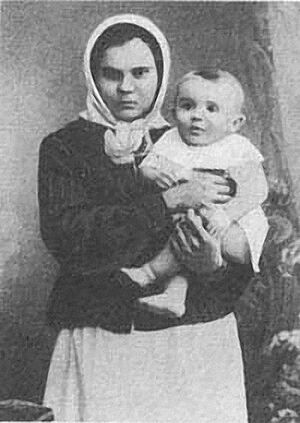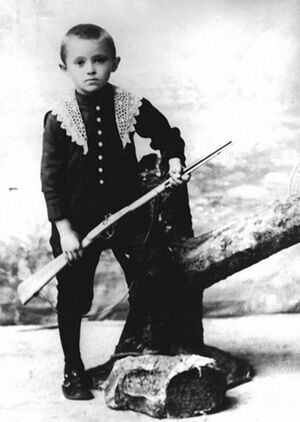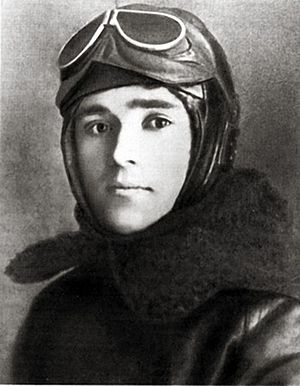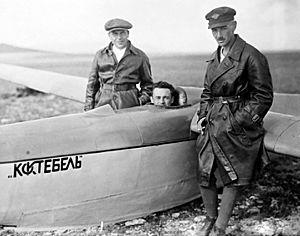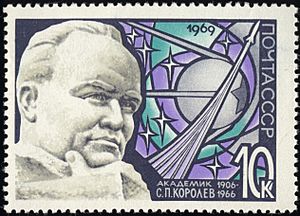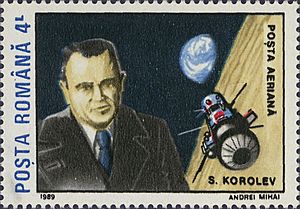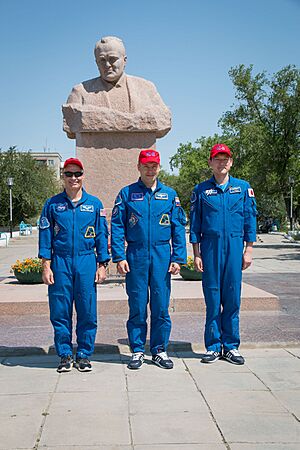Sergei Korolev facts for kids
Quick facts for kids
Sergei Korolev
|
|
|---|---|
| Сергей Королёв Сергій Корольов |
|
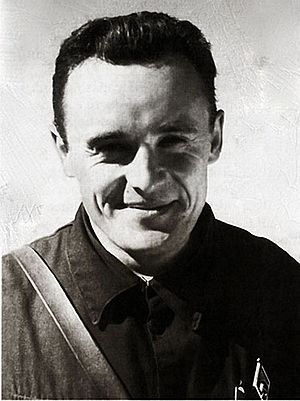
Korolev in 1934
|
|
| Born | 12 January 1907 [O.S. 30 December 1906] |
| Died | 14 January 1966 (aged 59) |
| Resting place | Kremlin Wall Necropolis, Moscow |
| Education | Kyiv Polytechnic Institute, Bauman Moscow State Technical University |
| Occupation | Rocket engineer, Chief Designer of the Soviet space program |
| Spouse(s) | Ksenia Vincentini Nina Ivanovna Kotenkova |
| Children | 1 |
| Military career | |
| Allegiance | Soviet Union |
| Service/ |
Soviet Army |
| Years of service | 1945–1952 |
| Rank | Polkovnik (colonel) |
| Signature | |
Sergei Pavlovich Korolev (Russian: Сергей Павлович Королёв, tr. Sergey Pavlovich Korolyov; Ukrainian: Сергій Павлович Корольов, romanized: Serhiy Pavlovych Korol'ov; January 12, 1907 – January 14, 1966) was a brilliant rocket engineer and spacecraft designer. He led the Soviet space program during the exciting Space Race of the 1950s and 1960s. Many people call him the "father of practical astronautics" because of his huge impact on space travel.
Korolev was key in creating the R-7 Rocket. This rocket launched many famous missions, including Sputnik 1, the first artificial satellite. He also helped send the dog Laika into space, launched Sputnik 3, and was behind the first human-made object to touch another planet (Luna 2). His work also put the dogs Belka and Strelka into orbit. Most famously, he helped send the first human, Yuri Gagarin, into space. Later, he oversaw the mission that allowed Alexei Leonov to perform the first ever spacewalk.
Even though Korolev trained to design airplanes, his real talent was in putting together complex projects. He was great at organizing and planning big missions. For a time, he was unfairly imprisoned for almost six years. After his release, he became a top rocket designer. He then led the Soviet space program, achieving early successes like the Sputnik and Vostok projects. This included Yuri Gagarin's historic flight on April 12, 1961. Korolev had big plans for a Soviet crewed mission to the Moon, but his unexpected death in 1966 stopped these plans. The United States landed on the Moon in 1969.
During the Cold War, Korolev was known only as Glavny Konstruktor (Главный Конструктор), or the Chief Designer. This was to protect him from possible attacks. Even some of the astronauts he worked with didn't know his real name. His identity was only revealed after he died in 1966. Then, he finally received public recognition for his amazing work in space exploration.
Contents
Early Life and Learning
Sergei Korolev was born in 1907 in Zhytomyr, a city in what is now Ukraine. His parents separated when he was young. Sergei grew up with his grandparents in Nizhyn. He was a quiet child who loved to read and was very good at math. He often focused on his studies because other kids sometimes teased him.
His stepfather, Grigory Balanin, was an electrical engineer and a good influence on young Sergei. In 1917, his family moved to Odessa. During the Russian Revolution, schools were closed, so Korolev studied at home.
Education Journey
Korolev went to the Odessa Building Trades School. He learned carpentry and other subjects. He became very interested in aeronautical engineering after seeing an air show in 1913. He started designing a glider and studied how planes fly. He also joined a local glider club.
In 1923, he joined the Society of Aviation and Aerial Navigation. He took his first flying lesson and often flew as a passenger in seaplanes. In 1924, he designed his own glider, the K-5. He wanted to go to the Zhukovsky Air Force Engineering Academy in Moscow but didn't meet the requirements.
Instead, he went to the Kiev Polytechnic Institute in 1924. He studied engineering, physics, and math. He later transferred to the Bauman Moscow State Technical University in 1926. There, he was mentored by the famous aircraft designer Andrei Tupolev. Korolev continued to fly gliders and powered aircraft. In 1929, he earned his diploma by designing a practical aircraft.
Early Career in Rocketry
After graduating, Korolev worked with top Soviet designers. He became interested in using liquid-fueled rocket engines for airplanes. He earned his pilot's license in 1930. He often wondered how to fly higher than any plane could go. Many believe this was the start of his interest in space.
In 1931, Korolev and space travel enthusiast Friedrich Zander helped create the Group for the Study of Reactive Motion (GIRD). This was one of the first groups in the USSR focused on rocket development. By May 1932, Korolev was the chief of GIRD. The military became interested and funded their projects. GIRD launched the first hybrid propellant rocket, the GIRD-09, in 1933. They also launched the Soviet Union's first liquid-fueled rocket, GIRD-X, that same year.
In 1933, GIRD merged with another group to form the Reactive Scientific Research Institute (RNII). This brought together the best Soviet rocket scientists. Korolev was a deputy head but was later demoted after a disagreement. He then worked on cruise missiles and a crewed rocket-powered glider. In 1934, he published a book called "Rocket Flight in Stratosphere."
Challenging Times
During the 1930s, many scientists and engineers in the Soviet Union faced difficult times. Korolev was wrongfully arrested in 1938. He was imprisoned for almost six years. Part of this time was spent in a harsh labor camp in Siberia, where conditions were very tough. He suffered injuries and health problems there.
Thanks to the help of his old mentor, Andrei Tupolev, Korolev was moved to a special prison for scientists and engineers in 1940. These places, called sharashkas, were like labs where prisoners worked on important projects for the government. During World War II, Korolev worked on designing bombers and rocket motors. He was finally released in 1944, but the charges against him were not officially dropped until 1957. His time in prison deeply affected him, making him more reserved and cautious.
Building Ballistic Missiles
In 1945, Korolev became a colonel in the Red Army. He was sent to Germany to study the technology of the German V-2 rocket. The Soviets worked with German experts to understand and copy this rocket. In 1946, a new institute, Scientific Research Institute No. 88 (NII-88), was created near Moscow for rocket development. Korolev became the chief designer of long-range missiles there.
Korolev showed great leadership by creating a "Council of Chief Designers." This group helped to speed up decisions and manage the early Soviet space program. His first task was to recreate the V-2 rocket, which became the R-1. He then pushed for more advanced designs.
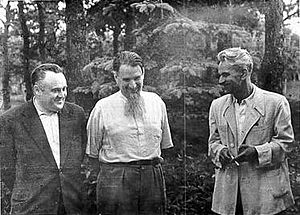
The R-2 doubled the range of the V-2. Next came the R-3, which could fly 3,000 kilometres (1,900 mi). This meant it could reach targets in England. However, the engines for the R-3 were not powerful enough, so the project was canceled.
Korolev then worked on the R-5, which had a range of 1,200 kilometres (750 mi) and flew successfully in 1953. His biggest achievement in missiles was the R-7 Semyorka. This was the world's first true intercontinental ballistic missile (ICBM). It was a powerful two-stage rocket that could carry a heavy nuclear bomb 7,000 kilometres (4,300 mi). The R-7 successfully launched on August 21, 1957. This success made the Soviet Union the first to have an ICBM, which was a huge national achievement. Korolev's name was kept secret, but he was nationally recognized.
Leading the Space Program
Korolev knew that his powerful R-7 rockets could do more than carry bombs. He saw their potential to launch satellites into space. In 1954, he suggested using the R-7 for a satellite launch, but the government wasn't interested at first. However, when the United States announced its own satellite program in 1955, Korolev pushed his idea again. He argued that launching a satellite first would bring great international prestige to the Soviet Union. This time, his proposal was approved.
Sputnik and Early Orbits
The Sputnik 1 satellite was designed and built in less than a month. Korolev personally managed its assembly. It was a simple metal sphere, about the size of a beach ball, with antennas and a radio transmitter. On October 4, 1957, Sputnik 1 was successfully launched into space using an R-7 rocket. It became the very first artificial satellite to orbit Earth.
This achievement shocked the world and had huge political effects. The Soviet leader, Nikita Khrushchev, was thrilled by the success. He asked Korolev to launch an even more advanced satellite quickly. Less than a month later, on November 3, Sputnik 2 was launched. This larger spacecraft carried the dog Laika into orbit. The entire vehicle was designed very quickly, with no time for full testing. Sadly, there was no way to bring Laika back to Earth, and she died from heat exhaustion after a few hours in space.
On May 15, 1958, Sputnik 3 was successfully launched. This satellite carried many instruments. It helped show the American government that the Soviets had strong ICBM capabilities.
Reaching for the Moon
Even before Sputnik 1, Korolev dreamed of reaching the Moon. He planned to modify the R-7 missile to send a package there. In 1958, his idea was approved. He called his lunar spacecraft Mechta, which means "dream" in Russian. Officially, they were called Lunas.
The first three lunar probes launched in 1958 failed. This was partly due to pressure to rush the launches without enough testing. The Luna 1 mission on January 2, 1959, was supposed to hit the Moon but missed. Still, it became the first probe to escape Earth's gravity and the first to go near the Moon. It also became the first human-made object to orbit the Sun.
Then, Luna 2 successfully hit the Moon's surface on September 14, 1959. This was another first for the Soviets. Just a month later, Luna 3 was launched. On October 7, 1959, it became the first spacecraft to photograph the far side of the Moon. This was something no one on Earth had ever seen before.
Korolev also worked on missions to land softly on the Moon. However, several attempts failed, with probes like Luna 4, Luna 5, Luna 6, Luna 7, and Luna 8 crashing. It was only after Korolev's death that the Soviet Union successfully achieved a soft landing with Luna 9.
Korolev's team also worked on missions to Mars and Venus. On November 1, 1962, the Soviet Union launched Mars 1. Although communications failed, it was the first spacecraft to fly by Mars. Later, Venera 3 became the first to impact Venus. Many of these planetary missions were fully successful only after Korolev's death.
Sending Humans to Space
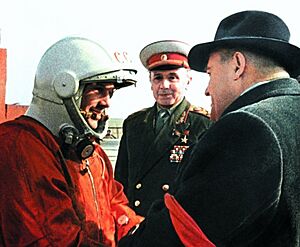
Korolev began planning for human spaceflight in 1958. He designed the Vostok spacecraft to carry a single person in a space suit. The spacecraft was spherical, like Sputnik. It had an escape system for problems before launch and a way to land safely.
In 1960, an uncrewed Vostok prototype orbited Earth, but its reentry failed. On July 28, 1960, two dogs, Chaika and Lishichka, were launched but died in an explosion. However, on August 19, the Soviet Union successfully brought living creatures back from space. The dogs, Belka and Strelka, completed eighteen orbits.
After these tests, a modified R-7 rocket launched Yuri Alexeevich Gagarin into orbit on April 12, 1961. This happened before the United States could send Alan Shepard into space. Korolev spoke to Gagarin during the flight. Gagarin became the first human in space and the first to orbit Earth. He returned to Earth by parachuting out of his capsule at 7 kilometres (23,000 ft) altitude. More Vostok flights followed, including Valentina Tereshkova becoming the first woman in space aboard Vostok 6.
Korolev also planned for the Soyuz craft, which could dock with other spacecraft in orbit. He was pushed by Khrushchev to achieve more "firsts" in space, including multi-crewed flights.
The Voskhod was an improved Vostok, designed to carry more people. Khrushchev wanted Korolev to launch three people quickly. Korolev agreed, asking for more support for his N-1 rocket program, which was meant for Moon missions. The Voskhod was made lighter by removing extra equipment. It also had larger parachutes for a safe landing.
After one uncrewed test, the Voskhod carried a crew of three cosmonauts on October 12, 1964. They completed sixteen orbits. This craft was designed for a soft landing, so the crew didn't need to eject.
To beat the Americans, the Soviets decided to perform a spacewalk on the second Voskhod launch. On March 18, 1965, Voskhod 2 launched, and Alexei Leonov performed the world's first spacewalk. The flight was very risky, and Leonov barely made it back into the spacecraft. Plans for more Voskhod missions were stopped. With a change in Soviet leadership, Korolev was given the task of beating the US to landing a man on the Moon.
For the Moon race, Korolev's team began designing the huge N1 rocket in 1961. He was also working on the Soyuz spacecraft and the Luna series for Moon landings and robotic missions to Mars and Venus. Sadly, he died in January 1966, before he could see these big plans completed.
Later Life and Legacy
Korolev faced health issues later in his life. He had his first heart attack in 1960. Doctors warned him that his intense work schedule was harming his health. He feared that the space program would be canceled if the Soviets fell behind the United States, so he kept pushing himself.
By 1962, Korolev had many health problems, including heart issues and fatigue. He also started losing his hearing from loud rocket engine tests.
His Death
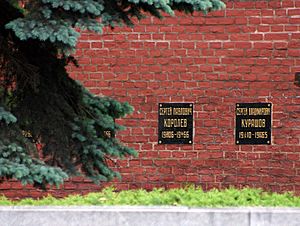
In December 1965, Korolev was diagnosed with a growth in his large intestine. He went into the hospital for surgery on January 5, 1966. He died nine days later. The government stated he had a large, cancerous tumor. His weak heart also contributed to his death during the operation.
Because of a Soviet policy, Korolev's identity was kept secret until after his death. This was to protect him from foreign agents. So, the Soviet people only learned about his amazing achievements after he passed away. His obituary was published in the Pravda newspaper on January 16, 1966, showing his photograph with all his medals. Korolev's ashes were buried with state honors in the Kremlin Wall Necropolis.
Sergei Korolev is often compared to Wernher von Braun, who led the American space program. Both were key figures in the Space Race. Korolev had to work with less advanced technology in some areas, especially electronics, and faced intense political pressure.
Korolev's successor was Vasily Mishin. Mishin inherited the challenging N1 rocket program, which unfortunately failed after several test launches. By 1972, the Americans had already landed on the Moon, and the N-1 program was canceled.
Honors and Legacy
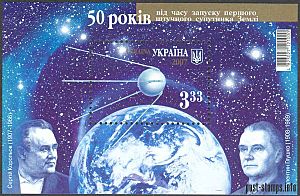
Korolev is remembered as a visionary leader in science and innovation. He was an engineer who could navigate the complex Soviet political system. He secured funding and support for space exploration, created a shared vision, and delivered incredible achievements that amazed the world.
Among his many awards, Korolev was named Hero of Socialist Labour twice, in 1956 and 1961. He also won the Lenin Prize in 1971 and received the Order of Lenin three times. In 1958, he was elected to the Academy of Sciences of the USSR.
Many places and things are named after him:
- A street in Moscow, Ulitsa Akademika Korolyova, was named after him in 1966.
- His home from 1959 to 1966 in Moscow is now a museum.
- The town of Kaliningrad (near Moscow) was renamed Korolev in his honor in 1996. This town is home to RSC Energia, Russia's largest space company.
- The crater Korolev on the far side of the Moon, a crater on Mars, and the asteroid 1855 Korolyov are all named after him.
- In his birth city of Zhytomyr, Ukraine, there is the Korolev Memorial Astronautical Museum.
- A visual effect seen during rocket staging is called the Korolev cross.
- Aeroflot named a Boeing 777 airplane after Korolev in 2021.
In 1990, Korolev was added to the International Air & Space Hall of Fame. In 1976, he was inducted into the International Space Hall of Fame.
Images for kids
-
"Chief Designer" Korolev (left) with "father of the Soviet atomic bomb" Igor Kurchatov (center) and "Chief Theoretician" Mstislav Keldysh (right), 1956
-
Korolev (right) with cosmonaut Yuri Gagarin and Marshal Kirill Moskalenko, before Gagarin's launch in Vostok 1 (1961)
-
Korolev's tomb (left) in the Kremlin Wall Necropolis
-
Korolev (left) and Valentin Glushko on a 2007 Ukrainian stamp
See also
 In Spanish: Serguéi Koroliov para niños
In Spanish: Serguéi Koroliov para niños


